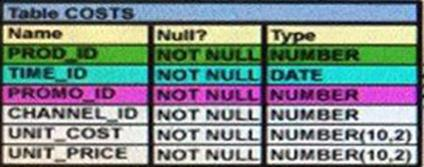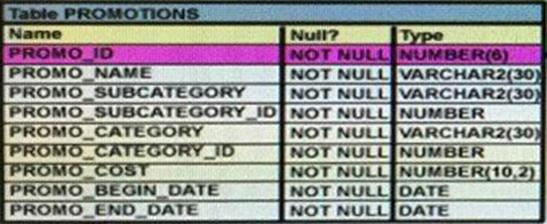Question: 1
The following are the steps for a correlated subquery, listed in random order:
The WHERE clause of the outer query is evaluated.
The candidate row is fetched from the table specified in the outer query.
This is repeated for the subsequent rows of the table, till all the rows are processed.
Rows are returned by the inner query, after being evaluated with the value from the candidate row in the outer query.
Which is the correct sequence in which the Oracle server evaluates a correlated subquery?
Answer : D
Show Answer
Hide Answer
Question: 2
Examine the data in the CUST_NAME column of the CUSTOMERS table.
CUST_NAME
-------------------
Renske Ladwig
Jason Mallin
Samuel McCain
Allan MCEwen
Irene Mikilineni
Julia Nayer
You need to display customers' second names where the second name starts with "Mc" or "MC".
Which query gives the required output?
Answer : C
Show Answer
Hide Answer
Question: 3
Evaluate the following SELECT statement and view the exhibit to examine its output:
SELECT constraint_name, constraint_type, search_condition, r_constraint_name, delete_rule, status,
FROM user_constraints
WHERE table_name = 'ORDERS';
CONSTRAINT_NAME
CON
SEARCH_CONDITION
R_CONSTRAINT_NAME
DELETE_RULE
STATUS
ORDER_DATE_NN
C
"ORDER_DATE" IS NOT NULL
ENABLED
ORDER_CUSTOMER_ID_NN
C
"CUSTOMER_ID" IS NOT NULL
ENABLED
ORDER_MODE_LOV
C
order _mode in ('direct', 'online')
ENABLED
ORDER TOTAL MIN
C
order total >= 0
ENABLED
ORDER PK
P
ENABLED
ORDERS CUSTOMER ID
R
CUSTOMERS ID
SET NULL
ENABLED
ORDERS SALES REP
R
EMP EMP ID
SET NULL
ENABLED
Which two statements are true about the output? (Choose two.)
Question: 4
Which statements are true? (Choose all that apply.)
Question: 5
View the exhibits and examine the structures of the COSTS and PROMOTIONS tables.


Evaluate the following SQL statement:
SQL> SELECT prod_id FROM costs
WHERE promo_id IN (SELECT promo_id FROM promotions
WHERE promo_cost < ALL
(SELECT MAX(promo_cost) FROM promotions
GROUP BY (promo_end_date-
promo_begin_date)));
What would be the outcome of the above SQL statement?